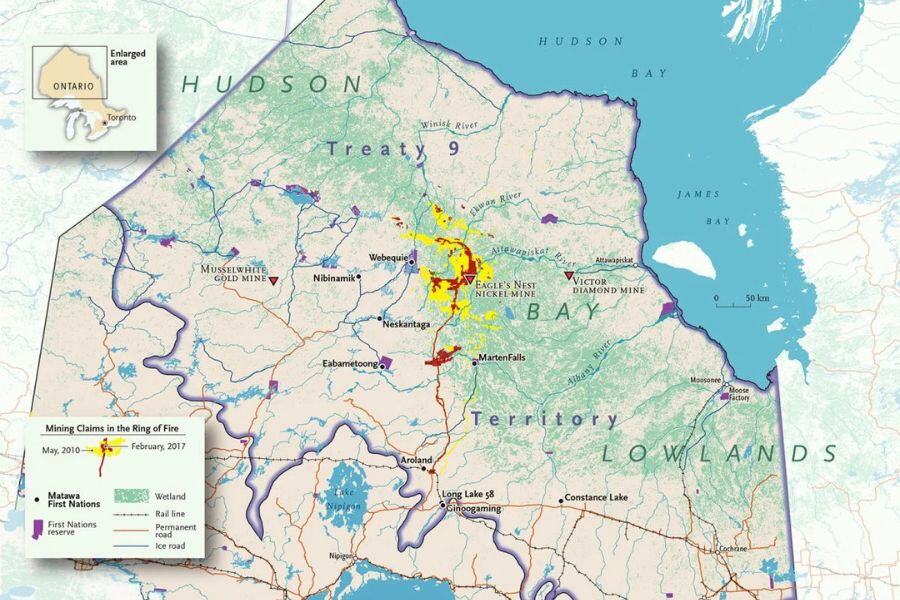Ring of Fire Development in Ontario

In June 2021, the Sierra Club Ontario Chapter initiated a crucial research project to evaluate the environmental and cultural impacts of the Ring of Fire, a mineral-rich region in Northwestern Ontario. Led by Joseph Duncan, an Indigenous member of Treaty Nine Territory, the study focused on the ecological importance of this 5,100 square kilometre area, home to the Nishnawbe Aski Nation. This region is vital to their way of life, supporting essential species like caribou and peatlands, and is integral to the cultural and economic practices of the Nation.
The research team, through interviews with Nishnawbe Aski Nation members and field visits, aimed to assess the environmental risks posed by the proposed mining projects. While the potential for economic benefits is clear, there are significant concerns regarding disruptions to migration patterns, as well as the long-term effects on Indigenous hunting and harvesting. Amid growing scepticism over the adequacy of consultation and the accuracy of information provided, the Nishnawbe Aski Nation remains steadfast in its commitment to protecting the land and ensuring any development respects their rights and cultural values.
Challenges
Projects that involve land and natural resources, like Ontario’s Ring of Fire, face several unique challenges that influence key stakeholders’ involvement and project viability. Despite its promise of sustainable outcomes, the Ring of Fire is hindered by significant obstacles, as identified by the Ontario Chamber of Commerce:
Transport Infrastructure
Inadequate infrastructure is the largest barrier, with long-term investment required to advance the project.
Energy Costs
High energy requirements for mineral processing add financial burdens for firms.
Labour Shortages
Filling critical roles remains challenging, impacting project timelines and efficacy.
Environmental and Regulatory Compliance
Strict standards demand solid mitigation strategies to avoid lasting ecological damage.
Federal Cooperation
Limited federal engagement, especially at bureaucratic levels, affects project prioritisation.
Public Awareness
Gaining public support is essential for smoother project progression and broader acceptance.
Solutions
The Ontario Chamber of Commerce has outlined a 13-step action plan to advance the Ring of Fire project. This plan emphasises critical priorities, such as building essential transportation infrastructure and establishing a new framework for comprehensive Indigenous involvement, ensuring collaboration from the project’s initiation to its completion. The steps are summarised below, focusing on ensuring sustainable development, enhancing community engagement, and meeting environmental and economic objectives.
Strategic investment in infrastructure and innovative environmental solutions is essential.
Develop roads and transportation networks with minimal ecological impact.
Implement advanced mining technology to reduce the carbon footprint of operations, supporting economic and environmental goals.
Engage stakeholders and conduct transparent consultations with Indigenous communities to align development with community needs.
Respect traditional knowledge to sustain both community trust and environmental standards.
Partnership Formation
A multi-party approach between the Ontario government, Indigenous groups, mining companies, and environmental organisations has been essential. Forming partnerships with Indigenous communities allows for co-management of resources, reflecting a commitment to Indigenous rights and traditional knowledge. These partnerships are formalised through agreements that outline each party’s responsibilities and benefits, establishing long-term trust and cooperation. Collaborating on shared goals enables stakeholders to better address social and environmental concerns, promoting economic opportunities that benefit all parties.
Project Scope and Objectives
The Ring of Fire project aims to responsibly extract critical minerals, support the transition to green technology, and stimulate economic growth in Northern Ontario. Project objectives include building sustainable infrastructure, reducing environmental impact, and enhancing socio-economic opportunities for Indigenous communities. This includes commitments to improving local employment, investing in education and skills training, and developing facilities with state-of-the-art environmental protections. By clearly defining these objectives, stakeholders can create a roadmap for balanced, sustainable development.
Impact and Benefits
The Ring of Fire project promises significant economic impact for Ontario. In the first decade, it is projected to generate up to $9.4 billion in GDP, contribute approximately $6.2 billion to Ontario's mining industry, and sustain around 5,500 full-time jobs annually. Government revenues could reach nearly $2 billion, benefiting federal, provincial, and municipal levels.
In the long term (over 32 years), the project could produce over $25 billion in GDP, contribute $16.7 billion to the mining sector, and generate $6.7 billion in government revenue. Additionally, it may bring $2.7 billion to financial services, $1.2 billion to trade, $600 million to manufacturing, and $500 million to utilities, reinforcing Ontario’s broader economic stability.
The Ring of Fire’s impact extends beyond Ontario, contributing to Canada’s role as a global leader in critical mineral production. Extracting valuable resources like nickel ensures the project can supply essential materials for electric vehicles and renewable energy infrastructure, directly supporting climate goals. Locally, the project’s development brings employment opportunities and infrastructure improvements to remote communities, enhancing economic stability. Environmental safeguards and Indigenous co-management ensure that development aligns with regional conservation goals.
Socioeconomic Benefits
Economically, the Ring of Fire project promises significant benefits for Northern Ontario and Indigenous communities, including job creation, investment in local businesses, and revenue generation. The project fosters economic resilience in the region, supporting both direct and indirect employment. Additionally, educational programmes and skill development initiatives aim to equip community members for future opportunities in the mining sector and beyond. Indigenous communities stand to benefit from revenue-sharing agreements, enabling reinvestment into community infrastructure, healthcare, and cultural initiatives.
Outcome
The Indigenous communities of Treaty 9 are taking a strong stance on the Ring of Fire project, which threatens their land, culture, and environment. With the proposed mining developments, infrastructure, and power generation, these communities are deeply concerned about the potential long-term impacts on the vast muskeg, one of the world’s largest peatlands and a critical carbon sink. They are calling for a more inclusive, Indigenous-led approach to decision-making, emphasising the need to protect the land, water, and future generations from the project’s harmful effects.
Rather than passively accepting the government's plans, the Indigenous peoples of Treaty 9 are advocating for responsible development that respects their values and ensures sustainability. They are pushing for continuous monitoring and robust oversight to minimise environmental damage, aiming to shape the project in a way that balances economic development with ecological preservation. Their efforts highlight the importance of integrating Indigenous knowledge and leadership into major development projects, setting a precedent for future initiatives that prioritise both people and the planet.
Ongoing Commitment - Regulatory Plans
The Ontario government’s Critical Minerals Strategy (2022-2027) outlines a long-term regulatory plan, emphasising sustainable practices and economic partnerships with Indigenous communities. This strategy includes regular environmental assessments, continuous stakeholder consultations, and adaptive management plans to address emerging issues. It prioritises responsible resource management, economic growth, and collaboration with Indigenous communities, aligning with the broader goals of environmental stewardship and economic empowerment. Through this strategic framework, the government reaffirms its commitment to a sustainable and inclusive development approach for the Ring of Fire.

Don’t miss an episode – Subscribe to our podcast!
Listen to invaluable insights from industry leaders. Join our podcast to delve deeper into the world of Indigenous communities, investments, and more. Don't miss an episode - follow our podcast today.
Don’t miss an episode – Subscribe to our podcast!
Listen to invaluable insights from industry leaders. Join our podcast, Drumbeats, to delve deeper into the world of Indigenous communities, investments, and more. Don't miss an episode - follow our podcast today.




